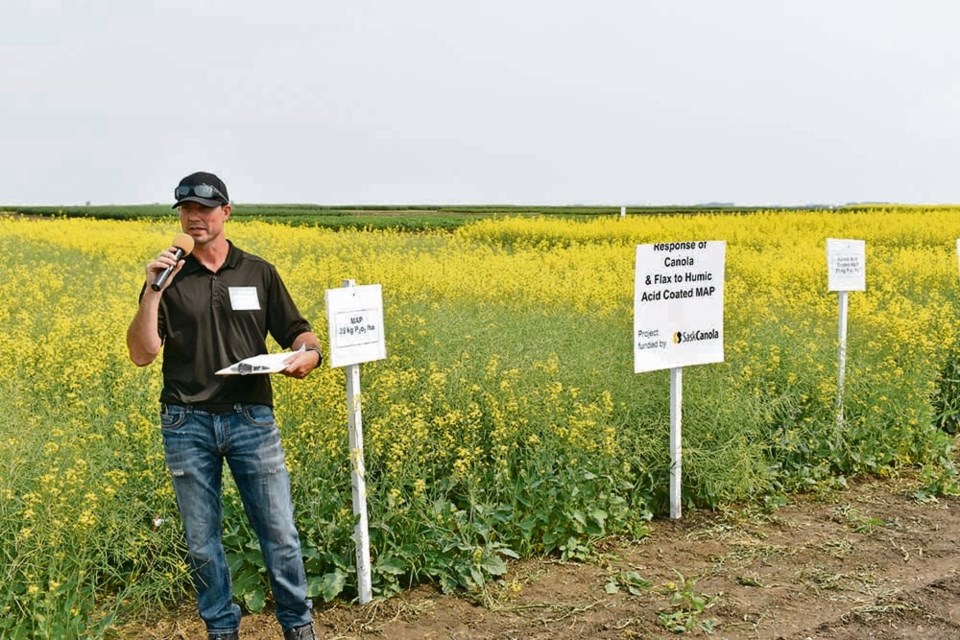OUTLOOK — Researchers continue to search for ways to help growers make nitrogen and phosphate fertilizer applications more efficient.
Derek Derdall, manager of Nutrien’s retail centre in Outlook, Sask., is looking at the possibility of coating phosphate fertilizer with a liquid form of humic acid, the natural acidic organic polymer, in hopes of improving germination and growth in canola and flax.
Derdall, who is leading a SaskCanola-funded research project at the Canada-Saskatchewan Irrigation Diversification Centre in Outlook, said he is aware of the current humic acid applications farmers have available and understands the benefit farmers have when applying humic acid to their crops.
By doing these trials, he hopes to prove certain things humic acid does for crops while demonstrating its purpose, in this instance over-fertilizing canola and flax with p2o5, which can result in poor germination and seed burn.
“All we were trying to do was figure out if applying humic acid to fertilizers is going to increase seed safety,” Derdall said at an Irrigation Crop Diversification Corp. field day.
“It’s supposed to tie up the salt effect, and also tie up the ammonia, making it safer for germinating seedlings.”
In the trials, Derdall and crew ran five different plots for canola as well as flax. For the flax, the first plot had no fertilizer. Then they bumped the phosphate 25 kilograms per hectare and finished with 50 kg per hectare.
Each fertilizer rate had a subsequent plot fertilized at the same rate but with the humic acid coating. Applications of 15 kg of phosphate per hectare or less is considered safe.
While the results won’t be complete until they carry out tissue tests and yield totals at the end of the year, early results are promising, especially in flax.
The germination rate without fertilizer for flax was 240 plants per sq. metre, but that saw a 25 percent decrease in germination at 25 kg of phosphate and a whopping 46 percent decrease at 50 kg.
With the humic acid applied, there was still a decrease in the germination, but significantly less. Plots with 25 kg of phosphate with humic saw only a 12.5 percent decrease in germination, while 50 kg of phosphate lost 33 percent.
The canola saw similar results, but less noticeable in comparison.
“It really showed in the flax,” said Derdall. “Once we were going above the safe seed placement rate of phosphate, this humic acid was reducing the damage the phosphate does to the seedlings.”
While rising soil pH levels are a concern for growers, applying humic won’t negatively affect your soil.
“It’s actually not an acid, it’s actually a base,” said Derdall. “It brings your pH closer to neutral.”
Rachelle McCannell, a soil science graduate student at the University of Saskatchewan, is looking at increasing nitrogen efficiency.
Her work at the ICDC is studying how canola uptakes nitrogen from the soil and from applied fertilizers to see how it affects the plant. She is using numerous hybrid, experimental and parental varieties in her plots.
“We’re looking at the different plant parts of the canola at the sampling period and its nitrogen uptake,” McCannell said at the ICDC field day.
“Then you can get a fuller picture of nitrogen uptake, and where this nitrogen is moving in the plant.”
She hopes her study can help improve canola genetics to create a more nitrogen efficient variety in the future.
McCannell has been building off the work of U of S professor Melissa Arcand and Agriculture Canada’s Sally Vail.
This two-year research project is McCannell’s thesis.
“I got hired on as the grad student to conduct the research, but they are the masterminds behind the development of this study,” said McCannell.
The trial will conclude after this year, but it began testing last year at Outlook and Saskatoon’s Agriculture Canada site. While the first year’s crop is off, she is waiting for the data from last year to be analyzed.
“Determining soil vs. fertilizer,” said McCannell. “We often just consider yield output for fertilizer added, but we’re going to take a more holistic look using this isotope. You can see nitrogen-use efficiency from a more in-depth perspective, and see how soil is contributing to nitrogen-use efficiency.”

